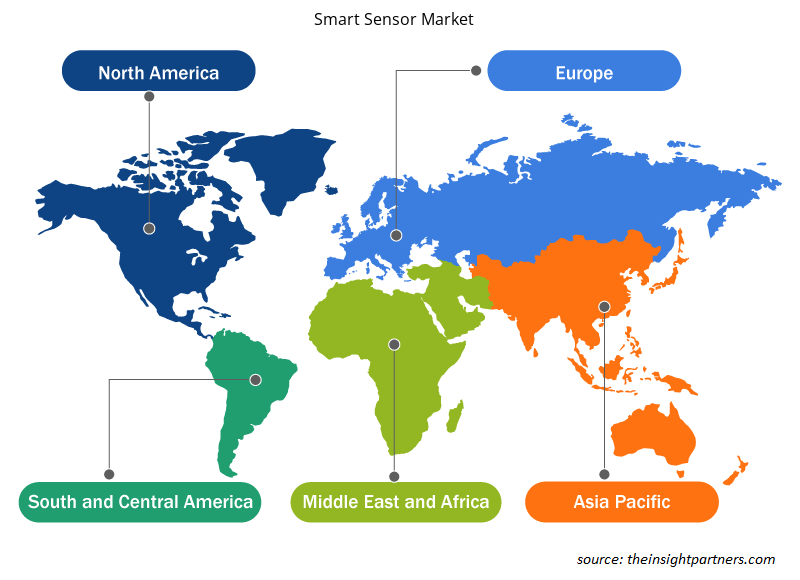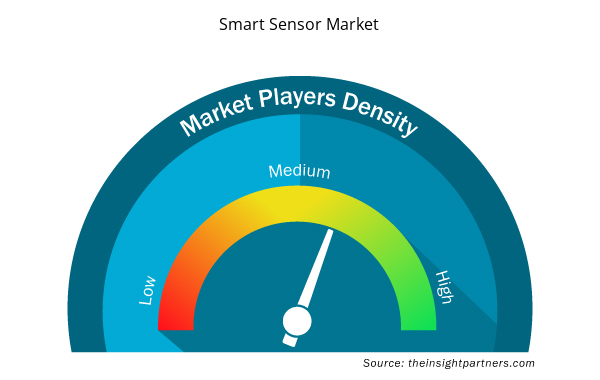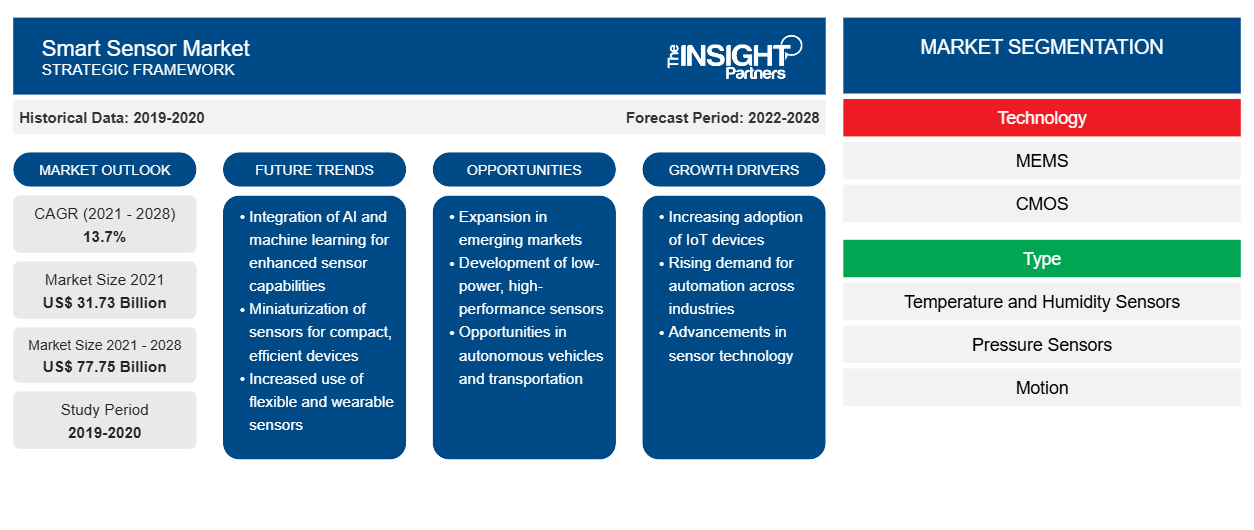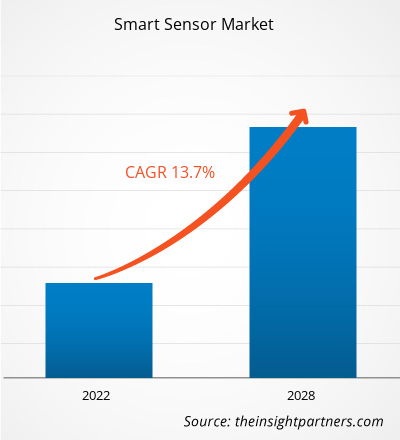スマートセンサー市場は、2021年の317億3,110万米ドルから2028年には777億4,760万米ドルに成長すると予想されています。2021年から2028年の間に13.7%のCAGRで成長すると予測されています。
スマート センサーは従来のセンサーよりも高速で正確です。これらのセンサーは従来のセンサーよりも小型で、消費電力も少なくなっています。IoT ベースのデバイスや民生用電子機器におけるスマート センサー技術の使用、および航空宇宙および防衛、自動車、生物医学およびヘルスケア、産業オートメーション、ビル オートメーション、民生用電子機器、教育、ロボット工学、農業、輸送の各業界におけるその応用は、ここ数年大きな注目を集めています。アプリケーション全体でのスマート センサーの使用の増加は、スマート センサー市場規模を押し上げる重要な要因です。
安全性とセキュリティへの懸念が高まる中、家電製品におけるスマートセンサーの需要が高まり、スマートセンサー市場に影響を与えています。ホームオートメーションでは、暗視IRセンサー、サウンドセンサーやマイク、スマートトイレなど、さまざまなセンサーが使用されています。企業は、自動クリーニング、自動フラッシング、タンク漏れ監視、水あふれ防止、健康監視など、さまざまな機能をスマートセンサーに組み込んでいます。照明やファンは、赤外線センサーやモーションセンサーを使用した自動システムで制御できます。
さらに、ライフスタイルの変化と新しい現代の生活水準により、ホームオートメーションと統合されたモジュラーキッチンの需要が急激に増加し、スマートセンサー市場にプラスの影響を与えています。メーカーは、振動、キッチンの音、光、ガス、温度、熱、電磁温度とノイズを監視するための合成センサーベースのデバイスを開発しており、スマートセンサー市場の規模を拡大しています。たとえば、Analog Devices, Inc. は HMC1126 GaAs pHEMT センサーを提供しています。これは、400 MHz ~ 52 GHz の範囲で動作する低ノイズアンプで、マイクロ波無線、超小型開口端末 (VSAT)、テスト機器、5G 通信などのさまざまなアプリケーションで使用されています。
要件に合わせてレポートをカスタマイズする
このレポートの一部、国レベルの分析、Excelデータパックなど、あらゆるレポートを無料でカスタマイズできます。また、スタートアップや大学向けのお得なオファーや割引もご利用いただけます。
- このレポートの主要な市場動向を入手してください。この無料サンプルには、市場動向から見積もりや予測に至るまでのデータ分析が含まれます。
スマートセンサー技術は、スマートフォンやウェアラブルデバイスの急速な技術進歩につながっています。自動車メーカーは、安全性と快適性を向上させるためにスマートセンサーの需要をますます高めています。スマートセンサーを搭載したセキュリティデバイスを監視および制御するためのワイヤレス技術の使用は、ますます一般的になりつつあります。COVID-19の流行中、スマートセンサー対応のウェアラブルデバイスの需要の急増、グリーンビルディング建設に対する政府の継続的な支援、および予測メンテナンスは、スマートセンサー市場のプレーヤーに有利な機会を提供しています。
スマートフォンの普及率の上昇は、スマートセンサー市場の成長に大きく貢献しています。スマートセンサーには、モーション、位置、周囲光、加速度計、ジャイロスコープなどの一般的なセンサーが含まれます。比吸収率(SAR)センサーは、スマートフォン、タブレット、ラップトップの5Gサブ6/4G/Wi-Fiなど、幅広いワイヤレステクノロジーの接続性を強化します。大手半導体サプライヤーのSEMTECHは、スマートフォン、ラップトップ、タブレット、ウェアラブルなどのさまざまなアプリケーションで使用できるPerSeTM Connect、PerSe Connect Pro、およびPerSe Controlセンサーを提供しています。
多くの企業が、マイクロコントローラを 1 つのパッケージに統合した新しい高度なスマート センサーを開発しています。AI (人工知能) や IoT などの最新技術により、この組み合わせを小型パッケージで実現できます。たとえば、Bosch Sensortec の BHA250 は、32 ビット マイクロコントローラと 14 ビット加速度センサーを 2.2 x 2.2 x 0.95 mm3 のパッケージに統合できます。さらに、TE Connectivity 社は、小さなスペースに機能を詰め込むために、センサーとコネクタを統合しました。スマート センサー技術のこれらの開発は、スマート センサー市場の成長にプラスの影響を与えています。スマート飲料自動販売機、スマート ホーム オートメーション システム、シンプルなコンピューター、デジタル アシスタント (Alexa など)、ヒューマン ウェアラブル デバイスなどの消費者向け電子産業の成長に伴い、スマート センサー市場ではスマート センサーの需要が高まっています。ノートパソコン、スマートフォン、テレビなどの従来の消費者向け製品は、ウェアラブル、音声起動スマート スピーカー、スマート ホーム デバイスなどの新製品や新興製品を消費者が引き続き採用しているため、期待を超え続けています。
複数の調査によると、今後数年間で数百億の IoT デバイスがインターネットに接続され、スマート センサー市場に大きな影響を与えることになります。COVID-19 は、都市政府が新たな現実に適応する中で、都市の回復力とデジタル変革戦略の議題を推進しています。
COVID-19パンデミックがスマートセンサー市場に与える影響
COVID-19 の出現により、遠隔患者モニタリングのためのデジタル インフラストラクチャの活用の必要性が明確に浮き彫りになりました。現在のウイルス検査とワクチンの開発が遅れているため、より堅牢な疾患検出と個人および集団の健康状態のモニタリングの必要性が高まっており、ウェアラブル センサーがこれに役立つ可能性があります。このテクノロジーの有用性は、生理学的指標を日常生活や人間のパフォーマンスと相関させるために使用されていますが、COVID-19 の発生を予測するために適用する必要性が依然としてあります。
省エネ機器の需要の高まりにより、北米のスマート センサー市場におけるスマート センサーの需要が高まっています。変化する状況により、エネルギー効率の高い機器や製品が必要となり、企業はエネルギー効率の高い省エネ機器へとシフトしています。さらに、政府の厳格な規制が解除され、オートメーション業界で勢いを増していることにより、スマート センサー市場におけるセンサーの需要はさまざまな業界で増加しています。さらに、自動車部門におけるセンサーの需要は、自動車の平均重量を軽減したいという要望によって推進されています。軽量自動車は、燃費とエネルギーの最適化の両方に役立ちます。
スマートセンサー市場の地域別洞察
予測期間を通じてスマート センサー市場に影響を与える地域的な傾向と要因は、Insight Partners のアナリストによって徹底的に説明されています。このセクションでは、北米、ヨーロッパ、アジア太平洋、中東、アフリカ、南米、中米にわたるスマート センサー市場のセグメントと地理についても説明します。

- スマートセンサー市場の地域別データを入手
スマートセンサー市場レポートの範囲
| レポート属性 | 詳細 |
|---|---|
| 2021年の市場規模 | 317.3億米ドル |
| 2028年までの市場規模 | 777.5億米ドル |
| 世界のCAGR(2021年~2028年) | 13.7% |
| 履歴データ | 2019-2020 |
| 予測期間 | 2022-2028 |
| 対象セグメント | テクノロジー別
|
| 対象地域と国 | 北米
|
| 市場リーダーと主要企業プロフィール |
|
市場プレーヤーの密度:ビジネスダイナミクスへの影響を理解する
スマート センサー市場は、消費者の嗜好の変化、技術の進歩、製品の利点に対する認識の高まりなどの要因により、エンド ユーザーの需要が高まり、急速に成長しています。需要が高まるにつれて、企業は提供内容を拡大し、消費者のニーズを満たすために革新を起こし、新たなトレンドを活用し、市場の成長をさらに促進しています。
市場プレーヤー密度とは、特定の市場または業界内で活動している企業または会社の分布を指します。これは、特定の市場スペースに、その規模または総市場価値と比較して、どれだけの競合相手 (市場プレーヤー) が存在するかを示します。
スマートセンサー市場で事業を展開している主要企業は次のとおりです。
- アナログ・デバイセズ株式会社
- インフィニオンテクノロジーズ株式会社
- STマイクロエレクトロニクス
- TEコネクティビティ
- マイクロチップテクノロジーズ
免責事項:上記の企業は、特定の順序でランク付けされていません。

- スマートセンサー市場のトップキープレーヤーの概要を入手
スマートセンサー市場のセグメンテーション
技術に基づいて、スマートセンサー市場はMEMS、CMOS、その他に分類されます。2021年には、MEMSセグメントが市場をリードしました。タイプに基づいて、スマートセンサー市場は、温度および湿度センサー、圧力センサー、モーションセンサー、位置センサー、その他に分類されます。2021年には、温度および湿度センサーセグメントが最大の市場シェアを占めました。最終用途産業に基づいて、スマートセンサー市場は、民生用電子機器、自動車、ヘルスケア、製造、小売、その他に分類されます。
スマート センサー市場の主要プレーヤーとしては、Analog Devices Inc.、Infineon Technologies Inc.、STMicroelectronics、TE Connectivity、Microchip Technologies、NXP Semiconductor、Siemens AG、ABB Ltd.、Robert Bosch GmbH、Honeywell International などが挙げられます。これらに加えて、世界のスマート センサー市場の全体的な動向を把握するために、他のプレーヤー数社も分析されました。
- 過去2年間の分析、基準年、CAGRによる予測(7年間)
- PEST分析とSWOT分析
- 市場規模価値/数量 - 世界、地域、国
- 業界と競争環境
- Excel データセット



Report Coverage
Revenue forecast, Company Analysis, Industry landscape, Growth factors, and Trends

Segment Covered
This text is related
to segments covered.

Regional Scope
North America, Europe, Asia Pacific, Middle East & Africa, South & Central America

Country Scope
This text is related
to country scope.
よくある質問
The Internet of Things (IoT) has accelerated the evolution of sensors to new heights. With the industry 4.0-powered cyber-physical transformation of manufacturing industries, many production facilities are taking up smart sensors. IoT platforms use a variety of sensors to deliver intelligence and data, allowing devices to function autonomously and the entire ecosystem to become more intelligent. Devices share information and improve their efficiency and functionality by combining a set of sensors and a communication network. The demand for IoT is growing in various industrial verticals, which, in turn, is supporting the growth of the smart sensor market.
In 2021, the market for temperature & humidity sensors held the largest market share. The demand for dependable, high-performance, low-cost sensors is growing, fueling the development of new technologies such as micro-and nanotechnology. Stick-on or printed sensors can be attached to equipment as labels to measure physical factors such as humidity, temperature, and gas pressure. Because of their inexpensive cost, compact size, and ease of use, the sensors are widely used in various sectors, including automobiles, homes, medical devices, the environment, food processing, and chemical. A temperature sensor's primary application is in a smart thermostat, a smart home device. Because of significant consumer interest, incremental technology breakthroughs, and increased accessibility, the total market for smart homes is expected to expand fast. Analog Devices, Inc., STMicroelectronics, TE Connectivity Corporation, Microchip Technology Inc., NXP Semiconductors, and other firms provide a wide range of temperature and humidity sensors to the global market.
MEMS is expected to dominate the smart sensor market during the forecast period. MEMS uses small miniaturized electromechanical and mechanical systems of actuators, sensors, and microelectronics. This technology is expected to continue to dominate the market for smart sensors in the coming years and to be the fastest-growing technology during the forecast period, owing to the numerous benefits it provides, including fast operations, high reliability, improved accuracy, easy maintenance, and replacement, and low energy and material consumption. This technology enables the sensor to perform intelligently by allowing them to store a significant quantity of data in the blink of an eye. The typical data obtained by the sensor is processed by the microprocessor, which erases or saves the data based on an advanced computation. The primary benefits of MEMS technology are reduced energy and material consumption, higher repeatability, increased accuracy, and increased sensitivity and selectivity. The MEMS segment is expected to have the most significant CAGR during the anticipated period. It is due to the increased use of IoT and wearable devices such as smartwatches. Smartwatches include tiny sensors, which contributes to an increase in the demand for MEMS technology for use in these devices. As a result, rising sales of smartwatches are likely to increase demand for MEMS technology throughout the forecasted period. Furthermore, the growing preference for smart homes would fuel the need for MEMS technology throughout the forecast period.
Many automotive manufacturers are coming up with new intelligent vehicles. They are more inclined toward cutting-edge smart sensors. APAC is expected to be the most important market for smart sensors vendors over the coming years in the automotive, infrastructure, consumer electronics, and pharmaceuticals industries, with China, India, and Japan demonstrating a significantly high demand. As the global manufacturing hub for various industries, including semiconductor and automotive, which produce home appliances, smartphones, computers, and peripheral devices, China's manufacturing sector has seen massive growth over the last few years. As a result, an enormous increase in the production and sale of sensing devices can be seen in this region. Long-range low-power wide-area network (LPWAN) technologies, such as NB-IoT, LoRa, LTE-M, and Sigfox, are fueling IoT vehicle connectivity innovation. LPWANs for IoT sensors allow low-power devices to wirelessly stream data packets over longer distances, as required in the automotive industry.
APAC dominated the smart sensor market in 2020. The APAC's vertical growth in the automotive, infrastructure, consumer electronics, and pharmaceuticals industries has positively impacted the smart sensor market. As the global manufacturing hub for various industries, such as semiconductor—which produces home appliances, smartphones, computers, and peripheral devices—and automotive, China's and India’s manufacturing sectors have seen massive growth. Consequently, an enormous increase in the sale and production of sensing devices can be seen in APAC. The growing population, low cost of smart sensors, the prominent existence of several manufacturing facilities, and rapid technological advancements in emerging markets are further contributing to the growth of the APAC smart sensor market.
Best-in-class sensors are highly secure and designed for indoor occupant analytics and energy savings, providing unprecedented precision in occupant detection, count, and movements and accurate reading of ambient lighting and motion sensing. These smart sensors can work as standalone devices or be integrated into other infrastructure appliances, such as thermostats or lighting fixtures, in keeping with the edge computing approach. As these intelligent building sensors can perform all analytics in-house, images are never stored or transmitted over the network, ensuring that occupants' privacy is fully protected. Biosensors and electronic, chemical, and smart grid sensors are in high demand in smart cities.
Trends and growth analysis reports related to Electronics and Semiconductor : READ MORE..
The List of Companies - Smart Sensor Market
- Analog Devices Inc.
- Infineon Technologies Inc.
- STMicroelectronics
- TE Connectivity
- Microchip Technologies
- NXP Semiconductor
- Siemens AG
- ABB Ltd.
- Robert Bosch GmbH
- Honeywell International Inc.
The Insight Partners performs research in 4 major stages: Data Collection & Secondary Research, Primary Research, Data Analysis and Data Triangulation & Final Review.
- Data Collection and Secondary Research:
As a market research and consulting firm operating from a decade, we have published and advised several client across the globe. First step for any study will start with an assessment of currently available data and insights from existing reports. Further, historical and current market information is collected from Investor Presentations, Annual Reports, SEC Filings, etc., and other information related to company’s performance and market positioning are gathered from Paid Databases (Factiva, Hoovers, and Reuters) and various other publications available in public domain.
Several associations trade associates, technical forums, institutes, societies and organization are accessed to gain technical as well as market related insights through their publications such as research papers, blogs and press releases related to the studies are referred to get cues about the market. Further, white papers, journals, magazines, and other news articles published in last 3 years are scrutinized and analyzed to understand the current market trends.
- Primary Research:
The primarily interview analysis comprise of data obtained from industry participants interview and answers to survey questions gathered by in-house primary team.
For primary research, interviews are conducted with industry experts/CEOs/Marketing Managers/VPs/Subject Matter Experts from both demand and supply side to get a 360-degree view of the market. The primary team conducts several interviews based on the complexity of the markets to understand the various market trends and dynamics which makes research more credible and precise.
A typical research interview fulfils the following functions:
- Provides first-hand information on the market size, market trends, growth trends, competitive landscape, and outlook
- Validates and strengthens in-house secondary research findings
- Develops the analysis team’s expertise and market understanding
Primary research involves email interactions and telephone interviews for each market, category, segment, and sub-segment across geographies. The participants who typically take part in such a process include, but are not limited to:
- Industry participants: VPs, business development managers, market intelligence managers and national sales managers
- Outside experts: Valuation experts, research analysts and key opinion leaders specializing in the electronics and semiconductor industry.
Below is the breakup of our primary respondents by company, designation, and region:

Once we receive the confirmation from primary research sources or primary respondents, we finalize the base year market estimation and forecast the data as per the macroeconomic and microeconomic factors assessed during data collection.
- Data Analysis:
Once data is validated through both secondary as well as primary respondents, we finalize the market estimations by hypothesis formulation and factor analysis at regional and country level.
- Macro-Economic Factor Analysis:
We analyse macroeconomic indicators such the gross domestic product (GDP), increase in the demand for goods and services across industries, technological advancement, regional economic growth, governmental policies, the influence of COVID-19, PEST analysis, and other aspects. This analysis aids in setting benchmarks for various nations/regions and approximating market splits. Additionally, the general trend of the aforementioned components aid in determining the market's development possibilities.
- Country Level Data:
Various factors that are especially aligned to the country are taken into account to determine the market size for a certain area and country, including the presence of vendors, such as headquarters and offices, the country's GDP, demand patterns, and industry growth. To comprehend the market dynamics for the nation, a number of growth variables, inhibitors, application areas, and current market trends are researched. The aforementioned elements aid in determining the country's overall market's growth potential.
- Company Profile:
The “Table of Contents” is formulated by listing and analyzing more than 25 - 30 companies operating in the market ecosystem across geographies. However, we profile only 10 companies as a standard practice in our syndicate reports. These 10 companies comprise leading, emerging, and regional players. Nonetheless, our analysis is not restricted to the 10 listed companies, we also analyze other companies present in the market to develop a holistic view and understand the prevailing trends. The “Company Profiles” section in the report covers key facts, business description, products & services, financial information, SWOT analysis, and key developments. The financial information presented is extracted from the annual reports and official documents of the publicly listed companies. Upon collecting the information for the sections of respective companies, we verify them via various primary sources and then compile the data in respective company profiles. The company level information helps us in deriving the base number as well as in forecasting the market size.
- Developing Base Number:
Aggregation of sales statistics (2020-2022) and macro-economic factor, and other secondary and primary research insights are utilized to arrive at base number and related market shares for 2022. The data gaps are identified in this step and relevant market data is analyzed, collected from paid primary interviews or databases. On finalizing the base year market size, forecasts are developed on the basis of macro-economic, industry and market growth factors and company level analysis.
- Data Triangulation and Final Review:
The market findings and base year market size calculations are validated from supply as well as demand side. Demand side validations are based on macro-economic factor analysis and benchmarks for respective regions and countries. In case of supply side validations, revenues of major companies are estimated (in case not available) based on industry benchmark, approximate number of employees, product portfolio, and primary interviews revenues are gathered. Further revenue from target product/service segment is assessed to avoid overshooting of market statistics. In case of heavy deviations between supply and demand side values, all thes steps are repeated to achieve synchronization.
We follow an iterative model, wherein we share our research findings with Subject Matter Experts (SME’s) and Key Opinion Leaders (KOLs) until consensus view of the market is not formulated – this model negates any drastic deviation in the opinions of experts. Only validated and universally acceptable research findings are quoted in our reports.
We have important check points that we use to validate our research findings – which we call – data triangulation, where we validate the information, we generate from secondary sources with primary interviews and then we re-validate with our internal data bases and Subject matter experts. This comprehensive model enables us to deliver high quality, reliable data in shortest possible time.


 このレポートの無料サンプルを入手する
このレポートの無料サンプルを入手する